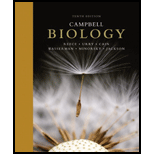
Concept explainers
In what ways are membranes crucial to life?
To explain: The importance of membrane that is crucial to life.
Concept introduction: Cell is the basic unit of life. All cells are bounded by the plasma membrane. Eukaryotic cell contain many organelles that perform specific functions. These include Golgi apparatus, mitochondria, nucleus, endoplasmic reticulum, chloroplasts, and lysosomes. They have well organized membrane-bound structures.
Explanation of Solution
The plasma membrane is crucial to life. Some of the features of a plasma membrane are mentioned below:
- Plasma membrane is made of phospholipid bilayer. It is hydrophobic in nature. Non-polar molecules easily dissolve in the plasma membrane and pass through it but polar or hydrophilic molecules require a channel protein to pass through plasma membrane.
- Plasma membrane is crucial to maintain the membrane fluidity. The organism found in the hot region will contain more saturated fatty acid in the plasma membrane. This will allow the membrane to be less fluidic. Similarly, the organism found in the cold region will contain more number of unsaturated fatty acids. This will allow the membrane to be more fluidic because unsaturated fatty acid will not allow tight-stacking of fatty acids.
- Plasma membrane has pores that allow the gap junctions to maintain a cytoplasmic environment to the local cells. This is helpful for the cells to work in harmony.
- Plasma membrane separates the organelle environment with the cytoplasm. This is helpful to maintain a local environment for enzymatic actions.
- Plasma membrane contains membrane protein that helps in the signal transduction. This maintains the communication between the cell and a foreign body.
Want to see more full solutions like this?
Chapter 7 Solutions
Campbell Biology (10th Edition)
Additional Science Textbook Solutions
Chemistry: The Central Science (14th Edition)
Microbiology Fundamentals: A Clinical Approach
Human Physiology: An Integrated Approach (8th Edition)
Organic Chemistry
Biochemistry: Concepts and Connections (2nd Edition)
- When beta-lactamase was isolated from Staphylcoccus aureus and treated with a phosphorylating agent, only the active site, serine was phosphorylated. Additionally, the serine was found to constitute 0.35% (by weight) of this beta-lactamase enzyme. Using this, calculate the molecular weight of this enzyme and estimate the number of amino acids present in the polypeptide.arrow_forwardBased on your results from the Mannitol Salt Agar (MSA) media, which of your bacteria were mannitol fermenters and which were not mannitol fermenters?arrow_forwardhelp tutor pleasearrow_forward
- Q8. A researcher wants to study the effectiveness of a pill intended to reduce stomach heartburn in pregnant women. The researcher chooses randomly 400 women to participate in this experiment for 9 months of their pregnancy period. They all need to have the same diet. The researcher designs two groups of 200 participants: One group take the real medication intended to reduce heartburn, while the other group take placebo medication. In this study what are: Independent variable: Dependent variable: Control variable: Experimental group: " Control group: If the participants do not know who is consuming the real pills and who is consuming the sugar pills. This study is It happens that 40% of the participants do not find the treatment helpful and drop out after 6 months. The researcher throws out the data from subjects that drop out. What type of bias is there in this study? If the company who makes the medication funds this research, what type of bias might exist in this research work?arrow_forwardHow do I determine the inhertiance pattern from the pedigree diagram?arrow_forwardits an open book assignemntarrow_forward
- Describe two different gene regulation mechanisms involving methylationarrow_forwardWhat is behavioral adaptarrow_forward22. Which of the following mutant proteins is expected to have a dominant negative effect when over- expressed in normal cells? a. mutant PI3-kinase that lacks the SH2 domain but retains the kinase function b. mutant Grb2 protein that cannot bind to RTK c. mutant RTK that lacks the extracellular domain d. mutant PDK that has the PH domain but lost the kinase function e. all of the abovearrow_forward
 Human Biology (MindTap Course List)BiologyISBN:9781305112100Author:Cecie Starr, Beverly McMillanPublisher:Cengage Learning
Human Biology (MindTap Course List)BiologyISBN:9781305112100Author:Cecie Starr, Beverly McMillanPublisher:Cengage Learning Biology (MindTap Course List)BiologyISBN:9781337392938Author:Eldra Solomon, Charles Martin, Diana W. Martin, Linda R. BergPublisher:Cengage Learning
Biology (MindTap Course List)BiologyISBN:9781337392938Author:Eldra Solomon, Charles Martin, Diana W. Martin, Linda R. BergPublisher:Cengage Learning Concepts of BiologyBiologyISBN:9781938168116Author:Samantha Fowler, Rebecca Roush, James WisePublisher:OpenStax College
Concepts of BiologyBiologyISBN:9781938168116Author:Samantha Fowler, Rebecca Roush, James WisePublisher:OpenStax College Human Physiology: From Cells to Systems (MindTap ...BiologyISBN:9781285866932Author:Lauralee SherwoodPublisher:Cengage Learning
Human Physiology: From Cells to Systems (MindTap ...BiologyISBN:9781285866932Author:Lauralee SherwoodPublisher:Cengage Learning





